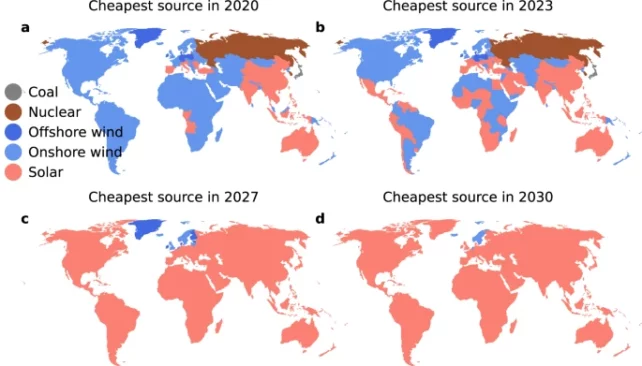After years of politicians trying to reboot the solar industry, the industry’s engines may have finally kicked into gear. Researchers in the UK have combined three different models to track developments in technology and economics, and simulations show that solar energy is on track to become the world’s main energy source.
The paper’s lead author, climate scientist Femke Nijse of the University of Exeter, predicts that even without additional government incentives such as a carbon tax, “solar energy will dominate the global energy balance by the middle of this century.”
Solar energy has been gaining momentum for years. In 2016, this form of renewable energy became the cheapest source of energy in more than 60 countries. The International Energy Agency announced that by 2020, solar energy will officially become the cheapest electricity in history, cheaper than coal and gas in most major countries.
Niisse and his colleagues believe that if costs continue to fall at the same rate, solar energy could eclipse all other alternative energy sources in just a decade or two. In 2020, fossil fuels produced more than 60 percent of electricity worldwide. New models predict that this number will drop to 21 percent by 2050. By comparison, solar energy will be responsible for 56 percent of world electricity production.
“If this were the case, a tipping point for renewables in the energy sector could be imminent or even passed, and policy and finance should prepare for a rapid, disruptive transition,” the team wrote.
To find this turning point, researchers ran a series of simulations based on the interaction between global energy, technology and the economy. In more than 70 percent of simulations, solar energy accounted for half of global electricity production by 2050.
“Due to the increasing co-evolution of technology costs and deployment, our analysis provides quantitative empirical evidence based on current and historical data trends that the tipping point for solar energy has likely been passed,” the researchers write.
“This suggests that solar dominance is not only possible but probable,” they add.
If this is indeed the case, rather than governments proposing additional incentives for solar power, Niisse and his colleagues argue that the world should now focus on paving the way for solar power to make the “inevitable” transition as smooth as possible.

Major obstacles to the technology’s dominance include lack of financing in low-income countries, a balanced and sustainable energy grid, increasing dependence on precious metals such as aluminum, and political resistance from a declining fossil fuel industry.
This last point is particularly important because there is no guarantee that solar dominance will deliver a zero-carbon system. Although Nysse and his team argue that “the baselines of predictions of fossil fuel dominance are no longer realistic,” there is a real possibility that coal and gas will find a way to stay.
“We conclude that achieving zero-carbon energy systems is likely to require different policies than those traditionally discussed by the energy modeling community,” the researchers wrote.
“The carbon price needed to achieve balance between renewable energy sources and fossil fuels may soon be zero. “Instead, it is policies that eliminate the above barriers that can contribute to achieving zero net energy emissions.”
Source: Port Altele
